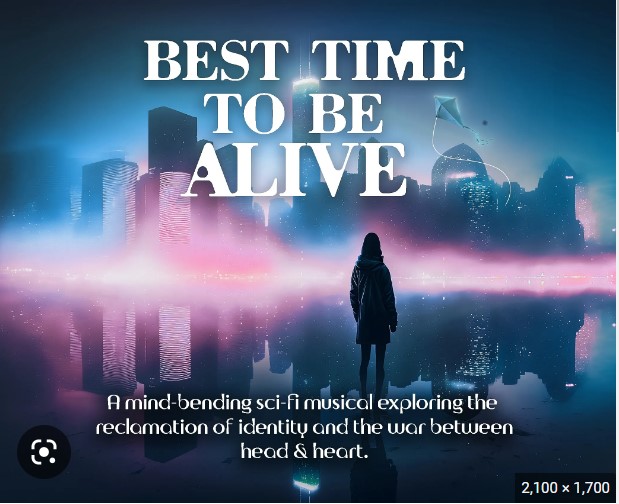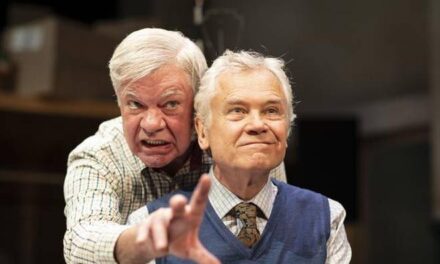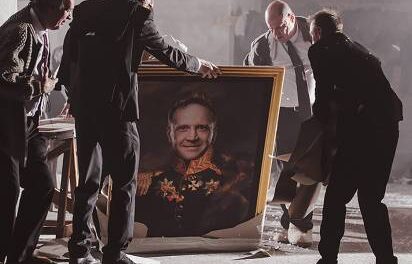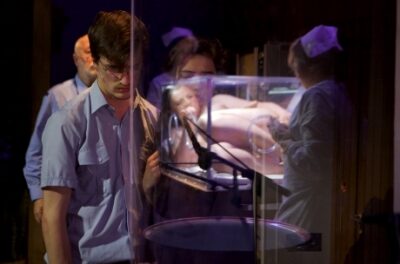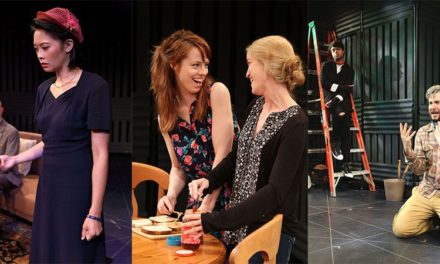On March 17, 2023, New York City’s Bedlam hosted the first industry reading of Best Time to Be Alive, which has been an ongoing project for its artists since 2019. Ready to hit its next benchmark for a live audience, the artistic triad (composed of the Librettist, Composer/Lyricist, and Dramaturg) gathered with me to discuss the meaning behind the story, and at times, quite literally, what a time it is to be alive.
The Bedlam Theater was looking for a new work, preferably a musical unlike any other when Composer and Lyricist, Renoir Kobashi, and Artistic Director, Eric Tucker, began their early collaboration. A few months later, Renoir found his concept while playing a road trip game with his wife. During a question game, he was asked, “If you could go back in time and change one relationship from your past, what would it be?” What came to mind was not the answer to the question but the answer to Bedlam; a sci-fi time-traveling musical.
The Artistic Triad
As the idea of time travel developed, Renoir Kobashi worked with his cohort of Providence College, Patrick Saunders to nail down their story over the course of the next year and a half, with Patrick acting as the artistic sounding board and Dramaturg to Kobashi’s early ideas. Rhiannon Ling was brought on in 2022 to act as the Librettist, and for the past 7 months has worked on the book of the show, helping to bridge Renoir and Patrick’s concepts and streamline them into their icurrent fruition. As an artistic trio, the three noted that their collaboration has been one of the most rewarding and effective experiences of the production, which has allowed the music, book, and lyrics to thread into one another to its current existence.
Sound Track Samples
Best Time to Be Alive is a sci-fi musical that examines the reclamation of identity and the inner conflict of having to choose to listen to either your head or heart when making difficult decisions. The show centers on its two main characters, Anna and Silas, a scientist and writer, whose meeting inevitably changes the world. This nonlinear time-traveling nerdy attraction is set in 1999 and is anything but traditional. On the website, the show shares some sneak peeks of the production, sampling several songs from the soundtrack, which anyone can take a listen off sound cloud. After previewing the three songs, the artists took a deep dive with me into the development of the music, and how their work led to influence the rest of the show and its characters.
Prologue
Patrick and Renoir noted that what initially started the process of the book was the focus on the music as a ‘concept album’ of sorts. From there, songs and story worked in tandem and with Rhiannon Ling’s addition, the show came into focus. From the “Prologue” to the song “Against the Wind” anyone who listens to the music and lyrics can see the layers of drama at play with clear themes, plot, character development, and good old fashion dramaturgy. The sound of the prologue is alien-esque and choral, with round overlaps that continue in an unending cannon to set the tone of the show. Patrick noted it was only once the prologue was fully formed that the other choices of the tone and themes of the work became clear, so finishing this song was really essential in the rest of the creative process. The prologue directly ties into the next song that starts the first scene, called “Round and Round” which articulates the interaction of Silas and Anna meeting on New Year’s Eve and sets the shows tone. In the beginning, one of the characters, Doctor Gilroy, the “Doc Brown” of the show as Renoir Kobashi recounted, helps to identify the interaction as the overseer scientist of sorts, and uses this initial song to help indicate how the universe is working in this world of the show for the audience.
Against the Wind
Later into the show, Anna’s character sings, “Against the Wind.” The song elaborates on the imagery of a Kite, which ignites an important metaphor about the power of breaking through expectations and doubt, and reclaiming identity. At this point in the musical, the story is taking a turn when Silas decides officially to go back in time. “Against the Wind” is full of scientific and anthropological facts and figures about the existence, operation, and history of Kites, which were surely a Dramaturg and Librettist’s dream assignment. Renoir Kobashi noted that he felt it was important to find a way to elaborate on how the kite worked for the sake of the other science at play in the work, and any listener would agree that it is working. The music has a bouncy yet rhythmic cadence to it that feels as light as the wind being described. However, as listeners take a moment to really hear the lyrics, it is clear the song is tapping into the larger themes of the production.
Themes at Play
Rhiannon Ling went on to elaborate on the reclamation of identity that this song taps into. “There is this running theme throughout, of all these characters, whether they are the protagonist or the secondary or the tertiary, that they are all doing something that makes them quite literally take off against the wind. They are all incredibly smart human beings that have strife and tragedy in their life that they have to overcome to figure out who they are and who they are in relation to other people. Which is essentially what a kite is doing, going against this wind of humanity to reach its highest capability.” Patrick added that the song’s jargon has a lot of intention which is felt by its characters and the rest of the work of this showcase, “it’s never science for science’s sake.”
The show’s larger themes bleed into all the songs of the show including a massive through line about understanding the intrinsic identity of oneself and its relationship to others. Rhiannon shared that all the characters deal with a form of trauma in the show and that this was done to exemplify the importance of being able to reclaim their voice and words, which was important and explored in this piece. Patrick added, “We as human beings have a duty to know our own identity and reclaim it in order to influence others and the rest of the world.”
Herstory
The final song “Herstory” is described by Renoir as another important watershed moment that assisted the rest of the creative process of the musical. Just as the title indicates, the song is a play on the word “history”, and has a lot of shifting perspectives and layers of thought. Renoir noted that when the story was still in its earlier more humble beginnings, that it wasn’t until “Herstory” was flushed out, that he realized the perspective of the story shouldn’t be in the eyes of Silas, but that of Anna’s, and it all began to click from there. Patrick added, that it really helped the group to avoid the “man saves woman” trope which also provided Anna’s character the agency she deserves in the show to highlight not only her accomplishments and independence but to also assist in flipping her dynamic from feeling lost in the development stage of her character work, to finally feeling like she was seen and fully complex.
When asked if the song was tapping into some feminist themes on the patriarchal structure society still functions in, Rhiannon elaborated. “To an extent, this song is representing the patriarchy and gender parity but it’s not in the sense that some people would think, it really explores the complexity of the ingraining of patriarchal values, and the entitlement that some folks feel to others’ identity…Silas is not a villain, it is more so illustrative of how their [Silas and Anna’s] life experiences affect both people and illustrates it from Anna’s perspective.”
What is Next
As the themes and character work of the show came to a close, the artists elaborated on what was to come for the production. Renoir noted that coming to the Bedlam would not be their first time, as they held a 29-hour workshop last year owever, they were all especially excited now that they have the book in hand to pair with the music and actors in order to see how audiences respond. Patrick noted that he is interested to see what the audience gets out of this phase of the process, and the takeaways that will enlighten their future revisions. “ Ultimately, I want to know if this was a unified story in the eyes of the audience. We are asking a lot creatively for the audience to follow along, we want to be a few steps ahead of the audience, not 29 steps ahead, so I am curious if we had that balance.” Renoir added that he’s curious to see what questions will pop up this time now that this is their second go around, and if they can answer these questions. Rhiannon said looking forward, they will of course be doing edits, and that they are grateful to Bedlam and hope in the near future to have a fully staged production thanks to feedback from this showcase.
You can check out all the exciting details about this show, the showcase, and its artists by following the production website. Please note, this event is by invitation only. For more information, contact renoir@besttimetobealive.com.
This post was written by the author in their personal capacity.The opinions expressed in this article are the author’s own and do not reflect the view of The Theatre Times, their staff or collaborators.
This post was written by Melissa Denzer.
The views expressed here belong to the author and do not necessarily reflect our views and opinions.

